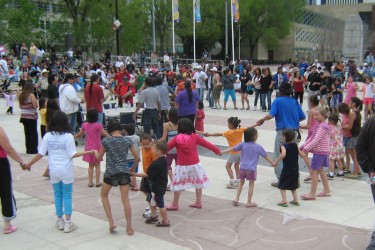Article Origin
Volume
Issue
Year
Of the roughly 9,000 children in foster care in Alberta, 70 per cent are Aboriginal. As a former foster child, Bernadette Iahtail knows firsthand about the negative impacts that can result when Aboriginal children are placed in foster care. Now as the co-founder and executive director of the Creating Hope Society, she is focused on finding solutions.
Formed in 2005, the Creating Hope Society is a non-profit organization whose goal is to end the historically devastating impacts of child welfare. Their work is focused on helping Aboriginal adults who were placed in care as children and finding solutions that better meet the needs of Aboriginal children, and their families, who are currently in care.
Bounced from foster home to foster home from ages five to 14, Iahtail grew up feeling displaced from her own community and an overall loss of identity which she attributes to being a foster child.
“When Aboriginal children are placed into adoptive or foster care, they are at risk of losing their language, heritage and understanding of where they come from,” she said.
She obtained closure as an adult when she revisited some of the communities where she was fostered. At one community, she wanted to know what happened to other children who were in foster care at the same time. “Out of 11 children, only four of us were alive,” she said. The others had died from addiction, illness and suicide.
To raise awareness of the Aboriginal children who have died in foster care and follow traditional ways of releasing a child’s spirit, the society holds an annual Blanket of Remembrance Round Dance. Open to the community, this year’s dance was held on May 21 at Winston Churchill Square in Edmonton.
Aside from building awareness, the society provides ongoing support through an advocacy group for families who are affected by the foster care and child welfare system. The purpose of the weekly group meetings is to inform parents of their rights and enable parents to become their own advocates. The group also collects stories of parents’ experiences with child welfare and most importantly, allows parents to see that they are not alone. The society also offers an afterschool program, cultural classes that teach drumming and dancing and resources on foster care.
Kinship care, said Iahtail, is the preferred alternative to placing Aboriginal children in foster care.
“We have to work with families to figure out what they need and what they want,” she said.
Kinship care is when a member of the extended family cares for a child when the mother and father are unable to do so. Through techniques like sharing circles, family conferencing and ample employment and educational supports, kinship care can become a viable solution.
By working directly with Aboriginal families and bringing a higher level of change and understanding by working with governmental and community organizations, the society hopes to achieve its declaration of an Aboriginal home for every Aboriginal child in care by 2025.
“It’s not about blaming anybody, but seeing what we can do together,” said Iahtail.
- 5365 views

